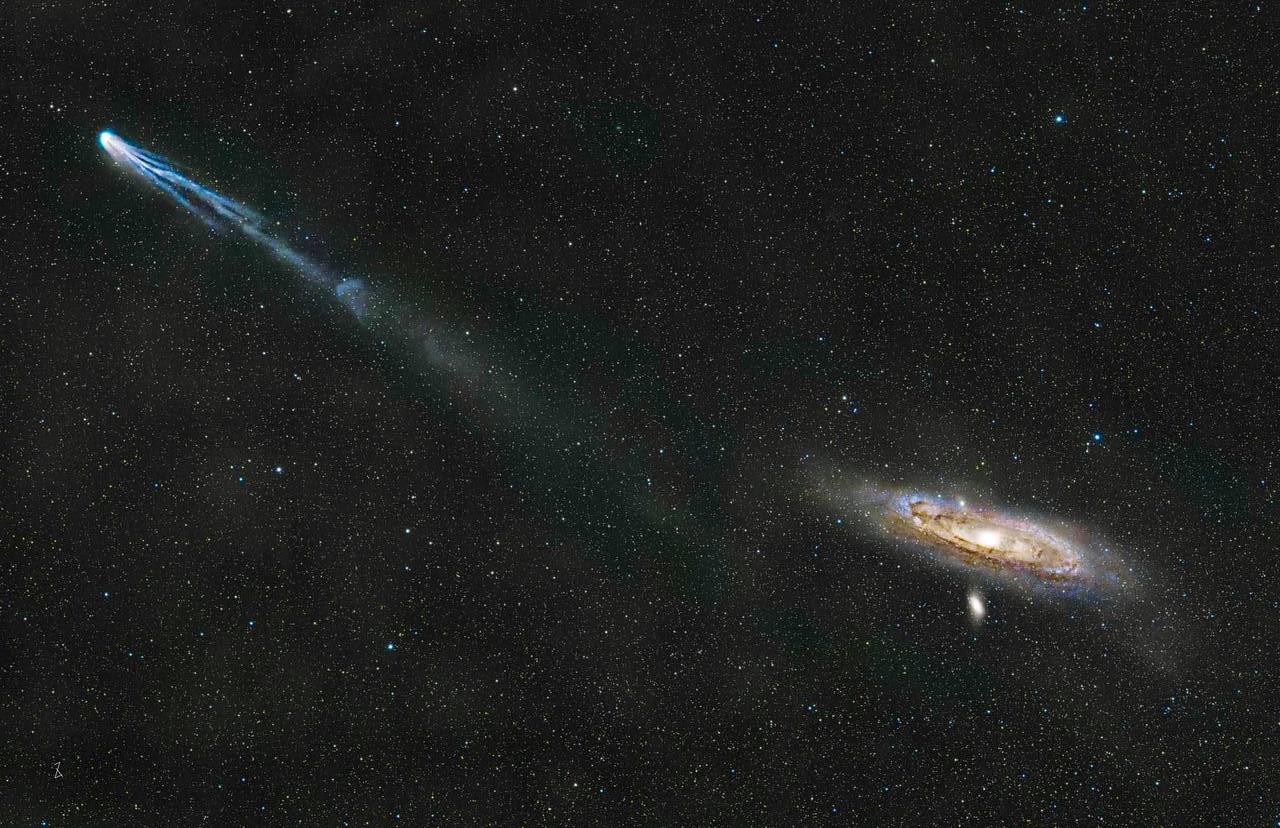Comet 12P

Comet Pons-Brooks is a long-period comet. In the history of astronomy as a natural science, this comet returns to the inner part of the Solar System for the 4th time. Its first observed visit, during which it was discovered, was in 1812 – it was then that the comet was discovered by the French astronomer Jean-Louis Pons. In 1883, it was rediscovered by William Robert Brooks, an American astronomer. In astronomy there is such a thing as “rediscovery”. Most often it concerns comets, because they are the ones that astronomers most often lose, and it takes someone else lucky to discover the lost celestial object (for which, for some reason, the exact predicted orbit was not determined) again.
The third visit of Comet Pons Brooks took place in 1954. In addition, there is reason to believe that the comets observed in 1385 and 1457 are still the same comet Pons-Brooks. People have probably observed this comet before, but it is not now possible to unambiguously identify these observations.
The average orbital period of Comet Pons-Brooks around the Sun is 71 years. At perihelion, it approaches the Sun closer than the Earth (but falls slightly short of the orbit of Venus), and at aphelion it goes beyond the orbit of Neptune. This makes the comet's orbit similar to that of Halley's Comet. Astronomers classify Comet Pons-Brooks as a Halley-type comet.
The comet itself is quite bright. But during the epoch of perihelion passage in 2024, it will pass from the Earth to the other side of the Sun, and it will hardly be observed satisfactorily. The latter circumstance has not prevented many astrophotographers from obtaining excellent photographs of the comet, although its perihelion is still ahead – April 21, 2024. At that moment, the comet will be located at a distance of one and a half astronomical units from the Earth – this is very far, and this does not pose a danger, just as it does not allow the comet to be seen with the eye. And although the maximum brightness of the comet is expected to be at the level of 4th magnitude (which is comparable to the brightness of the Orion Nebula or the Andromeda galaxy), the proximity of the comet to the Sun will not allow it to be observed in a dark sky – only in the twilight dawn. And in the northern hemisphere of the Earth, by that time the comet will sink significantly below the ecliptic and will cease to be visible at all.
But it is in the last days of March 2024 that the comet is more or less satisfactorily visible in the evenings in the northern hemisphere.
Let's take a closer look at the conditions for its visibility.
March 21, 2024, evening

The comet moves across the northern part of the constellation Pisces – within the asterism “Northern Pisces”, near the Triangulum galaxy – M33, and in the sky is located at approximately the same angular altitude as Jupiter, but in the constellation adjacent to it. The brightness of the comet predicted by the Stellarium program should be 4.85m, but in fact now the comet is slightly brighter than the calculated values - about 4.5m.
March 22, 2024, evening

The comet continues to move through the northern part of the constellation Pisces, moving away from the above-mentioned asterism towards the constellation Aries. The calculated brightness is slightly brighter than 4.8m. The duration of visibility in mid-northern latitudes can be more than two hours. But you will need a location with an extremely open view to the west.
March 23, 2024, evening

The comet is still in Pisces, in the northern part of the constellation. Daily displacements against the background of distant stars do not exceed one degree. The estimated brightness is about 4.7m, the angular distance from the Sun is 32 degrees to the northeast. The distance from the Sun to the comet is about 1 astronomical unit, but between the comet and the Earth is 1.6 AU – we actually see the comet from behind the Sun. What plays in our favor is that the comet is located significantly north (higher) of the Sun.
March 24, 2024, evening

The comet is located near the northern part of the border of the constellations Pisces and Triangulum. The calculated gloss is 4.67m. Duration of evening visibility more than 2 hours
March 25, 2024, evening

The comet is located near the northern part of the border of the constellations Pisces, Triangulum and Aries. Predicted brightness ~4.6m. The duration of visibility still exceeds 2 hours.
March 26, 2024, evening

This is the last evening of Comet Pons-Brooks's stay in the constellation Pisces. Otherwise, visibility conditions are no different from previous evenings. Predicted magnitude 4.56m. Elongation from the Sun is 31 degrees.
March 27, 2024, evening

The comet moves into the constellation Aries. Its estimated brightness reaches 4.5m, visibility begins at an altitude of about 20 degrees above the point of the west – this is not too high, but still acceptable (at about this altitude on winter nights we can see the Orion Nebula). But in any case, to observe the comet you will need some kind of optics, because you will have to look for the comet at dusk.
March 28, 2024, evening

The predicted brightness of the comet will be 4.44m. Visibility conditions are essentially the same as the previous evening.
March 29, 2024, evening

The comet is approaching the rather bright (at least noticeable) star “Gamal” – alpha Aries. The brightness of this star corresponds to the average brightness of the stars of Ursa Major, and it is a good reference point for searching for a comet that will be 7-8 times fainter than the star. The precalculated brightness of the comet is 4.39m. But no one can say for sure what it will be like in reality, although most likely the comet will be somewhat brighter.
March 30, 2024, evening

The comet is located less than 1 degree to the west of Alpha Aries. The predicted magnitude is 4.33m, and the angular distance from the Sun is 29 degrees. At the same time, the duration of visibility is already less than 2 hours. Visibility conditions are gradually deteriorating.
March 31, 2024, evening


Comet Pons-Brooks passes 20 arcminutes (less than the diameter of the lunar disk) from the star Gamal – Alpha Aries. It's definitely worth watching. The brightness of the comet is expected to be 4.28m, but in reality it is most likely about 4m or even higher. We are waiting for beautiful astrophotography from advanced observers.
April 1, 2024, evening

On the first evening of April, the comet will move somewhat away from the star Alpha Aries. Its visibility will decrease a little more and its height above the horizon will decrease, but the comet continues to be visible in the northern hemisphere of the Earth, and its brightness is increasing.
I'll pause here. The second part of the review – for the first half of April – will appear in the coming days, and I will hasten to publish this part.
In conclusion, I leave you with a photograph of Comet Pons-Brooks from an astrophotographer Stephane Vetter.






